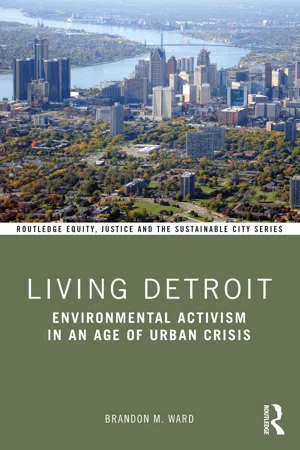
Living Detroit
Environmental Activism in an Age of Urban Crisis
Brandon M. Ward
- 200 páginas
- English
- ePUB (apto para móviles)
- Disponible en iOS y Android
Living Detroit
Environmental Activism in an Age of Urban Crisis
Brandon M. Ward
Información del libro
In Living Detroit, Brandon M. Ward argues that environmentalism in postwar Detroit responded to anxieties over the urban crisis, deindustrialization, and the fate of the city. Tying the diverse stories of environmental activism and politics together is the shared assumption environmental activism could improve their quality of life.
Detroit, Michigan, was once the capital of industrial prosperity and the beacon of the American Dream. It has since endured decades of deindustrialization, population loss, and physical decay – in short, it has become the poster child for the urban crisis. This is not a place in which one would expect to discover a history of vibrant expressions of environmentalism; however, in the post-World War II era, while suburban, middle-class homeowners organized into a potent force to protect the natural settings of their communities, in the working-class industrial cities and in the inner city, Detroiters were equally driven by the impulse to conserve their neighborhoods and create a more livable city, pushing back against the forces of deindustrialization and urban crisis. Living Detroit juxtaposes two vibrant and growing fields of American history which often talk past each other: environmentalism and the urban crisis. By putting the two subjects into conversation, we gain a richer understanding of the development of environmental activism and politics after World War II and its relationship to the crisis of America's cities.
This book will be of great interest to students and scholars in environmental, urban, and labor history.
Preguntas frecuentes
Información
1 LIVING JUST ENOUGH FOR DETROIT

Sick in the city
Wartime environments
Índice
- Cover
- Half Title
- Series Page
- Title Page
- Copyright Page
- Dedication Page
- Table of Contents
- List of illustrations
- Acknowledgments
- Archival abbreviations
- Introduction: The many lives of Earth Day
- 1 Living just enough for Detroit
- 2 The environmental quest for a livable region
- 3 Factories, fields, and streams
- 4 The UAW confronts the urban environmental crisis
- 5 Black environmentalism in an age of urban crisis
- 6 Environmentalism in the fragmented metropolis
- Epilogue: Age of crises
- Index